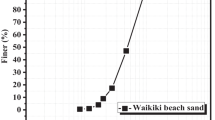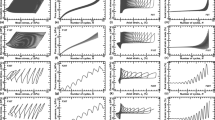Abstract
Bio-mediated techniques have the potential to be an eco-friendly and sustainable solution for engineering problems in the presence of unfavorable soil conditions. During the microbial induced carbonate precipitation (MICP) process, calcium carbonate is the byproduct of a series of biological and chemical reactions in the soil media. Although the shear response of MICP-treated sands with different calcium carbonate content has been extensively investigated, the behavior of this material subjected to varying stress paths with different levels of cementation and particle sizes is still unknown. In this study, the material behavior of MICP-treated sands under axisymmetric compression, radial extension, constant p', and constant q stress paths at moderate and heavy level of cementation is evaluated by conducting drained triaxial tests on specimens with relative density of about 40%. Shear wave velocity was measured during the course of treatment and shearing to monitor cementation and degradation processes. In addition, the effect of stress relaxation and compression after bio-treatment on shear response is evaluated. A previously proposed nonlinear failure envelope for MICP-treated sands is also verified by comparing the shear and normal stresses at failure with those predicted by the nonlinear failure envelope.








Similar content being viewed by others
Abbreviations
- A :
-
Is shear strength parameters in \(\tau = P_{{\text{a}}} A\left( {\frac{\sigma }{{P_{{\text{a}}} }} + T} \right)^{n}\)
- D :
-
Particle diameter
- n :
-
Is shear strength parameters in \(\tau = P_{{\text{a}}} A\left( {\frac{\sigma }{{P_{{\text{a}}} }} + T} \right)^{n}\)
- n' :
-
Is a constant indicating the dependency of shear wave velocity to effective stress
- p' :
-
Is mean effective stress (kPa)
- P a :
-
Is atmospheric pressure (kPa)
- q :
-
Is deviatoric stress (kPa)
- (q/p')failure :
-
Is stress ratio at failure
- T :
-
Is shear strength parameters in \(\tau = P_{{\text{a}}} A\left( {\frac{\sigma }{{P_{{\text{a}}} }} + T} \right)^{n}\)
- V s :
-
Is shear wave velocity (m/s)
- V s1 :
-
Is normalized shear wave velocity at 100 kPa (m/s)
- \(\sigma _{1}^{\prime }\) :
-
Is major principal effective stress (kPa)
- \(\sigma _{3}^{\prime }\) :
-
Is minor principal effective stress and effective confining pressure (kPa)
References
Cheng L, Shahin MA, Chu J (2019) Soil bio-cementation using a new one-phase low-pH injection method. Acta Geotech 14:615–626. https://doi.org/10.1007/s11440-018-0738-2
Das B, Yen S, Dass R (1995) Brazilian tensile strength test of lightly cemented sand. Can Geotech J 32:166–171
DeJong JT, Fritzges MB, Nüsslein K (2006) Microbially induced cementation to control sand response to undrained shear. J Geotech Geoenviron Eng 132(11):1381–1392. https://doi.org/10.1061/ASCE1090-02412006132:111381
DeJong JT, Mortensen BM, Martinez BC, Nelson DC (2010) Bio-mediated soil improvement. Ecol Eng 36:197–210. https://doi.org/10.1016/j.ecoleng.2008.12.029
Do J, Montoya BM, Gabr MM (2019) Debonding of microbially induced carbonate precipitation-stabilized sand by shearing and erosion. Geomech Eng 17(5):429–438
Evans TM, Khoubani A, Montoya BM (2014) Simulating mechanical response in bio-cemented sands. Comput Methods Recent Adv Geomech 2014:1569–1574
Feng K, Montoya BM (2015) Influence of confinement and cementation level on the behavior of microbial-induced calcite precipitated Sands under monotonic drained loading. J Geotech Geoenviron Eng 2(Atcc 11859):4015057
Feng K, Montoya BM, Evans TM (2017) Discrete element method simulations of bio-cemented sands. Comput Geotech 85:139–150. https://doi.org/10.1016/j.compgeo.2016.12.028
Gai X, Sánchez M (2019) An elastoplastic mechanical constitutive model for microbially mediated cemented soils. Acta Geotech 14:709–726. https://doi.org/10.1007/s11440-018-0721-y
Gomez MG, Graddy CMR, Dejong JT, Nelson DC, Tsesarsky M (2017) Stimulation of native microorganisms for biocementation in samples recovered from field-scale treatment depths. J Geotech Geoenviron Eng 144(1):10. https://doi.org/10.1061/(ASCE)GT.1943-5606.0001804
Ismail MA, Joer HA, Randolph MF, Meritt A (2002) Cementation of porous materials using calcite. Géotechnique 52:313–324
Khoubani A, Nafisi A, Evans MT, Montoya BM (2018) The effect of grain size and shape on mechanical behavior of MICP sand II: numerical study. In: Proceedings of international symposium on bio-mediated and bio-inspired geotechnics, Atlanta 2018
Lin H, Suleiman MT, Brown DG, Kavazanjian E (2015) Mechanical behavior of sands treated by microbially induced carbonate precipitation. J Geotech Geoenviron Eng. https://doi.org/10.1061/(ASCE)GT.1943-5606.0001383
Martinez BC (2012) Up-Scaling of microbial induced calcite precipitation in sands for gotechnical ground improvement. University of California, Davis
Mitchell JK, Santamarina JC (2005) Biological considerations in geotechnical engineering. J Geotech Geoenviron Eng 131(10):1222–1233. https://doi.org/10.1061/(ASCE)1090-0241(2005)131:10(1222)
Montoya BNA. Shear response of bio-cemented sands with varying particle sizes under different stress paths. DesignSafe-CI 2019. https://doi.org/10.17603/DS2-T1V1-TF58
Montoya BM, DeJong JT (2015) Stress-strain behavior of sands cemented by Microbially Induced Calcite Precipitation. J Geotech Geoenviron Eng 141(6):4015019. https://doi.org/10.1061/(ASCE)GT.1943-5606.0001302
Montoya BM, DeJong JT, Boulanger RW (2013) Dynamic response of liquefiable sand improved by microbial-induced calcite precipitation. Géotechnique 63(4):302–312. https://doi.org/10.1680/geot.SIP13.P.019
Mortensen BM, Haber MJ, Dejong JT, Caslake LF, Nelson DC (2011) Effects of environmental factors on microbial induced calcium carbonate precipitation. J Appl Microbiol 111(2):338–349. https://doi.org/10.1111/j.1365-2672.2011.05065.x
Nafisi A, Mocelin D, Montoya BM, Underwood S (2020) Tensile strength of sands treated with microbially induced carbonate precipitation. Can Geotech J 57(10):1611–1616. https://doi.org/10.1139/cgj-2019-0230
Nafisi A, Montoya BM (2018) A new framework for identifying cementation level of MICP-treated sands. In: IFCEE, Orlando
Nafisi A, Montoya BM, Evans TM (2020) Shear strength envelopes of bio-cemented sands with varying particle size and cementation level. J Geotech Geoenviron Eng 146(3):04020002
Ning Z, Khoubani A, Evans TM (2017) Particulate modeling of cementation effects on small and large strain behaviors in granular material. Granul Matter 19(1):7. https://doi.org/10.1007/s10035-016-0686-1
Qabany A, Soga A (2013) Effect of chemical treatment used in MICP on engineering properties of cemented soils. Geotechnique 63(4):331–339. https://doi.org/10.1680/geot.SIP13.P.022
Safavizadeh S (2017) Evaluating the effect of MICP treatment on the structural and chemical stabilization of coal ash impoundments. North Carolina State Univ. https://doi.org/10.1061/(ASCE)GT.1943-5606.0001682
Sun X, Linchang M, Tong T, Wang C (2019) Study of the effect of temperature on microbially induced carbonate precipitation. Acta Geotech 14:627–638. https://doi.org/10.1007/s11440-018-0758-y
Van Paassen LA, Ghose R, Van Der Linden TJM, Van Der Star RLW, Van Loosdrecht MCM (2010) Quantifying biomediated ground improvement by ureolysis: large-scale biogrout experiment. J Geotech Geoenviron Eng Geoenviron Eng 136(12):1721–1728. https://doi.org/10.1061/ASCEGT.1943-5606.0000382
Whiffin VS, Van Paassen LA, Harkes MP (2007) Microbial carbonate precipitation as a soil improvement technique. Geomicrobiol J 24:417–423. https://doi.org/10.1080/01490450701436505
Xiao Y, Chen H, Stuedlein AW, Evans TM, Chu J, Cheng L, Jiang N, Lin H, Liu H, Aboel-Naga HM (2020) Restraint of particle breakage by biotreatment method. J Geotech Geoenviron Eng 146:04020123. https://doi.org/10.1061/(asce)gt.1943-5606.0002384
Xiao Y, Zhao C, Sun Y, Wang S, Wu H, Chen H, Liu H (2020) Compression behavior of MICP-treated sand with various gradations. Acta Geotech. https://doi.org/10.1007/s11440-020-01116-2
Zamani A, Montoya BM (2018) Undrained monotonic shear response of MICP-treated silty sands. J Geotech Geoenviron Eng 144(6):4018029. https://doi.org/10.1061/(ASCE)GT.1943-5606.0001861
Acknowledgements
Funding from the National Science Foundation (CMMI #1537007, 1538460, and 1554056) is appreciated. Any opinions, findings, and conclusions presented in this paper are those of the writers and do not necessarily reflect the opinions of the National Science Foundation.
Author information
Authors and Affiliations
Corresponding author
Additional information
Publisher's Note
Springer Nature remains neutral with regard to jurisdictional claims in published maps and institutional affiliations.
Rights and permissions
About this article
Cite this article
Nafisi, A., Liu, Q. & Montoya, B.M. Effect of stress path on the shear response of bio-cemented sands. Acta Geotech. 16, 3239–3251 (2021). https://doi.org/10.1007/s11440-021-01286-7
Received:
Accepted:
Published:
Issue Date:
DOI: https://doi.org/10.1007/s11440-021-01286-7




